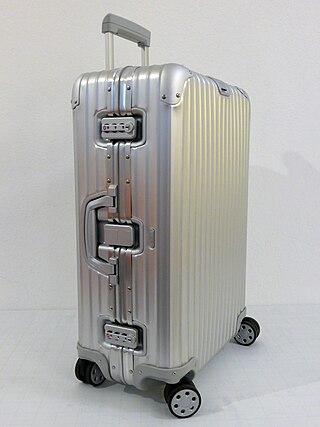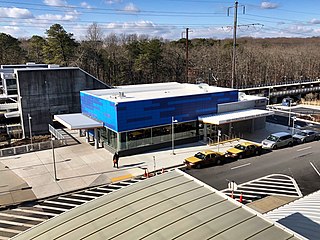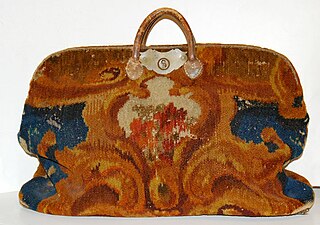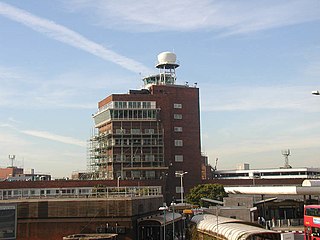
A suitcase is a form of luggage. It is a rectangular container with a handle and is typically used to carry one's clothes and other belongings while traveling. The first suitcases appeared in the late 19th century due to the increased popularity of mass tourism at the time and were meant to hold dress suits. They were originally made using heavier materials such as leather or steel, but, beginning in the 1930s, were constructed with more lightweight materials like plastic and cardboard.

Checked baggage is luggage delivered to an airline or train for transportation in the hold of an aircraft, storage on a coach bus or baggage car of a passenger train. Checked baggage is inaccessible to the passenger during the flight or ride, as opposed to carry-on baggage.

Lost luggage is luggage conveyed by a public carrier such as an airline, seafaring cruise ship, shipping company, or railway which fails to arrive at the correct destination with the passenger. In the United States, an average of 1 in 150 people have their checked baggage misdirected or left behind each year.

A combine car in North American parlance, most often referred to simply as a combine, is a type of railroad car which combines sections for both passengers and freight.

The Superliner is a type of bilevel intercity railroad passenger car used by Amtrak, the national rail passenger carrier in the United States. Amtrak commissioned the cars to replace older single-level cars on its long-distance trains in the Western United States. The design was based on the Budd Hi-Level cars used by the Santa Fe Railway on its El Capitan trains. Pullman-Standard built 284 cars, known as Superliner I, from 1975 to 1981; Bombardier Transportation built 195, known as Superliner II, from 1991 to 1996. The Superliner I cars were the last passenger cars built by Pullman.

In airport terminals, a baggage reclaim area is an area where arriving passengers claim checked-in baggage after disembarking from an airline flight. The alternative term baggage claim is used at airports in the US and some other airports internationally. Similar systems are also used at train stations served by companies that offer checked bags, such as Amtrak in the United States.

Baggage or luggage consists of bags, cases, and containers which hold a traveler's personal articles while the traveler is in transit. A modern traveler can be expected to have packages containing clothing, toiletries, small possessions, trip necessities. On the return trip, travelers may have souvenirs and gifts. For some people, luggage and the style thereof is representative of the owner's wealth and status. Luggage is constructed to protect the items during travel either with a hard shell or a durable soft material. Luggage often has internal subdivisions or sections to aid in securing items. Handles are typically provided to facilitate carrying, and some luggage may have wheels and/or telescoping handles or leashes to make moving them easier.

BWI Rail Station is an intermodal passenger station in Linthicum, Maryland near Baltimore/Washington International Airport (BWI). It is served by Amtrak Northeast Corridor intercity trains, MARC Penn Line regional rail trains, and several local bus lines.

In the airline industry, a baggage handler is a person who loads and unloads baggage, and other cargo for transport via aircraft. With most airlines, the formal job title is "fleet service agent/clerk", though the position is commonly known amongst airline employees as a "ramp agent", due to the job's location on the airport ramp (tarmac).

A carpet bag is a top-opening travelling bag made of carpet, commonly from an oriental rug. It was a popular form of luggage in the United States and Europe in the 19th century, featuring simple handles and only an upper frame, which served as its closure. Some small modern versions are used as handbags or purses.

The term hand luggage or cabin baggage refers to the type of luggage that passengers are allowed to carry along in the passenger compartment of a vehicle instead of a separate cargo compartment. Passengers are allowed to carry a limited number of smaller bags with them in the vehicle, which typically contain valuables and items needed during the journey. There is normally storage space provided for hand luggage, either under seating, or in overhead lockers. Trains usually have luggage racks above the seats and may also have luggage space between the backs of seats facing opposite directions, or in extra luggage racks, for example, at the ends of the carriage near the doors.

The Airport Line is a route of the SEPTA Regional Rail commuter rail system in Philadelphia, Pennsylvania, which officially runs between Philadelphia International Airport through Center City to Temple University station. In practice, however, only a few trains originate or terminate at Temple University; most are through routed with lines to the north after leaving the Center City Commuter Connection. Half of weekday trains are through routed with the Warminster Line, with the other half of weekday trains through routed with the Fox Chase Line. All weekend and holiday trains are through routed with the Warminster Line and terminate either in Warminster or Glenside.

Bag tags, also known as baggage tags, baggage checks or luggage tickets, have traditionally been used by bus, train, and airline carriers to route checked luggage to its final destination. The passenger stub is typically handed to the passenger or attached to the ticket envelope:
- to aid the passenger in identifying their bag among similar bags at the destination baggage carousel;
- as proof—still requested at a few airports—that the passenger is not removing someone else's bag from the baggage reclaim hall; and
- as a means for the passenger and carrier to identify and trace a specific bag that has gone astray and was not delivered at the destination. The carriers' liability is restricted to published tariffs and international agreements.

A baggage carousel is a device, generally at an airport, that delivers checked luggage to the passengers at the baggage reclaim area at their final destination. Not all airports use these devices. Airports without carousels generally deliver baggage by placing it on the floor or sliding it through an opening in a wall.

The Kalamazoo Transportation Center is an intermodal complex in downtown Kalamazoo, Michigan. Amtrak and Greyhound provide regular service there. The center is also the major downtown transfer hub for Kalamazoo's Metro Transit bus system.

The 2006 transatlantic aircraft plot was a terrorist plot to detonate liquid explosives, carried aboard airliners travelling from the United Kingdom to the United States and Canada, disguised as soft drinks. The plot was discovered by British Metropolitan police during an extensive surveillance operation. A number of security measures were taken in response to the 2006 transatlantic aircraft plot.

A baggage handling system is a type of conveyor system installed in airports that transports checked luggage from ticket counters to areas where the bags can be loaded onto airplanes. A baggage handling system also transports checked baggage coming from airplanes to baggage claims or to an area where the bag can be loaded onto another airplane.

Baggage carts, luggage carts, luggage trolleys or trolleys are small vehicles pushed by travelers (human-powered) to carry individual luggage, mostly suitcases. There are two major sizes: One for big luggage and one for small luggage. Carts have usually two parts for carrying luggage: A small section (basket) for carry on luggage at the same level as the handle, and a lowered large section for suitcases a small and large bags.

Airport check-in is the process whereby an airline approves airplane passengers to board an airplane for a flight. Airlines typically use service counters found at airports for this process, and the check-in is normally handled by an airline itself or a handling agent working on behalf of an airline. Passengers usually hand over any baggage that they do not wish or are not allowed to carry in the aircraft's cabin and receive a boarding pass before they can proceed to board their aircraft.

On the commercial transportation, mostly with airlines, the baggage allowance is the amount of checked baggage or hand/carry-on luggage the company will allow per passenger. There may be limits on the amount that is allowed free of charge, and hard limits on the amount that is allowed.




















